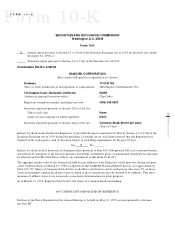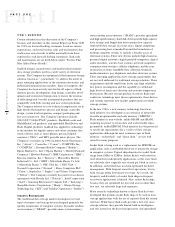SanDisk 1998 Annual Report Download - page 19
Download and view the complete annual report
Please find page 19 of the 1998 SanDisk annual report below. You can navigate through the pages in the report by either clicking on the pages listed below, or by using the keyword search tool below to find specific information within the annual report.
SanDisk Corporation
14
expend significant resources to develop non-infringing tech-
nology, discontinue the use of certain processes or obtain
licenses to the infringing technology. Any litigation, whether
as a plaintiff or as a defendant, would likely result in signifi-
cant expense to the Company and divert the efforts of the
Company’s technical and management personnel, whether or
not such litigation is ultimately determined in favor of the
Company. In addition, the results of any litigation matter
are inherently uncertain.
In the event the Company desires to incorporate third party
technology into its products or is found to infringe on others’
patents or intellectual property rights, the Company may be
required to license such patents or intellectual property rights.
The Company may also need to license some or all of its
patent portfolio to be able to obtain cross-licenses to the
patents of others. The Company currently has patent cross-
license agreements with Hitachi, Intel, Samsung, Sharp, SST
and Toshiba. From time to time, the Company has also
entered into discussions with other companies regarding
potential cross-license agreements for the Company’s patents.
However, there can be no assurance that licenses will be
offered or that the terms of any offered licenses will be
acceptable to the Company. If the Company obtains licenses
from third parties, it may be required to pay license fees or
make royalty payments, which could have a material adverse
effect on the Company’s gross margins. The failure to obtain
a license from a third party for technology used by the
Company could cause the Company to incur substantial
liabilities and to suspend the manufacture of products or the
use by the Company’s foundries of processes requiring the
technology, or to expend substantial resources redesigning
its products to eliminate the infringement. There can be no
assurance that the Company would be successful in redesigning
its products or that such licenses would be available under
reasonable terms. Furthermore, any such development or
license negotiations could require substantial expenditures
of time and other resources by the Company.
As is common in the industry, the Company agrees to
indemnify certain of its suppliers and customers for alleged
patent infringement. The scope of such indemnity varies, but
may in some instances include indemnification for damages
and expenses, including attorneys’ fees. The Company may
from time to time be engaged in litigation as a result of such
indemnification obligations.
In its efforts to maintain the confidentiality and ownership
of trade secrets and other confidential information, the
Company requires all employees (regular and temporary),
consultants, foundry partners, certain customers, suppliers and
partners to execute confidentiality and invention assignment
agreements upon commencement of a relationship with the
Company and extending for a period of time beyond termi-
nation of the relationship. There can be no assurance that
these agreements will provide meaningful protection for the
Company’s trade secrets or other confidential information in
the event of unauthorized use or disclosure of such informa-
tion. See “Factors That May Affect Future Results—Our
Operating Results May Fluctuate Significantly.”
Backlog
The Company manufactures and markets primarily standard
products. Sales are generally made pursuant to standard
purchase orders. The Company includes in its backlog only
those customer orders for which it has accepted purchase
orders and assigned shipment dates within the upcoming
twelve months. Since orders constituting the Company’s
current backlog are subject to changes in delivery schedules,
backlog is not necessarily an indication of future revenue. In
addition, there can be no assurance that the current backlog
will necessarily lead to revenues in any future period. As of
December 31, 1998, the Company’s total backlog was $13.4
million compared to $18.6 million at December 31, 1997.
Bookings visibility continues to be limited with more than
50% of the Company’s quarterly product revenues coming
from turns business. The Company believes that the current
situation will continue until the new markets addressed by
the Company’s products enter a more predictable growth
phase and demand begins to create longer lead times. See
“Factors That May Affect Future Results—Fluctuations in
Operating Results.”
Competition
The flash data storage markets in which the Company
competes are characterized by intense competition, rapid
technological change, evolving industry standards, rapidly
declining average selling prices and rapid product obsoles-
cence. The Company’s competitors include many large
domestic and international companies that have greater access
to wafer fab capacity, substantially greater financial, technical,
marketing and other resources, broader product lines and
longer standing relationships with customers than the
Company. The Company’s primary competitors include flash
chip producers such as Advanced Micro Devices, Inc. (“AMD”),
Atmel Corporation (“Atmel”), Hitachi, Intel, Micron
Technology, Inc. (“Micron”), Mitsubishi Electronic
Corporation (“Mitsubishi”), Samsung, Sharp and Toshiba,
other companies using data storage techniques such as socket
flash, linear flash and system flash components, as well as
package assemblers such as Kingston Technology Company
(“Kingston”), Lexar Media, Inc. (“Lexar”), M-Systems, Inc.
(“M-Systems”), Simple Technology Inc. (“Simple”), SMART
Modular Technologies, Inc. (“SMART Modular”), Sony
Corporation (“Sony”), TDK Corporation (“TDK”),
Matsushita Battery, Inc. (“Matsushita Battery”) and Viking
Components, Inc. (“Viking”) that combine controllers and
flash memory chips developed by others into flash data storage
cards. Approximately twenty-five companies have been certified
by the CompactFlash Association to manufacture and sell
their own brand of CompactFlash. The Company believes
that other manufacturers, such as Toshiba and Samsung, will
also seek to enter the CompactFlash market in the future.
























